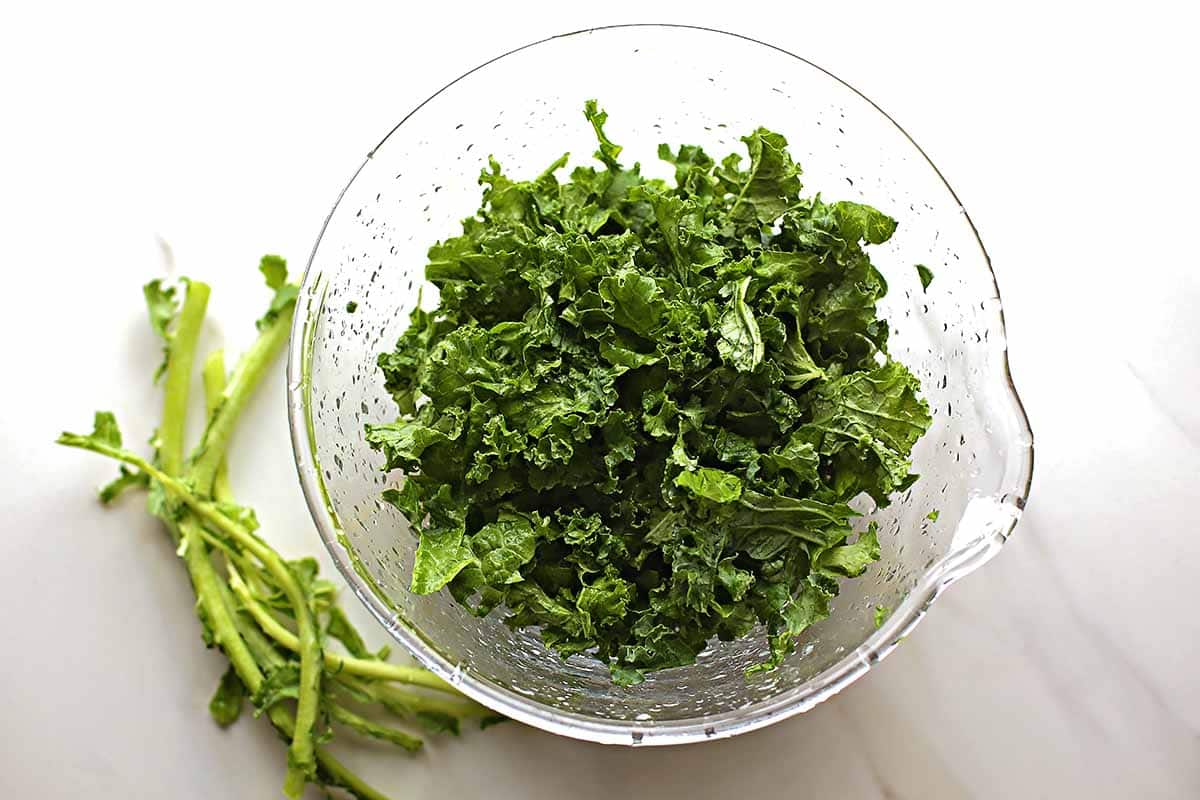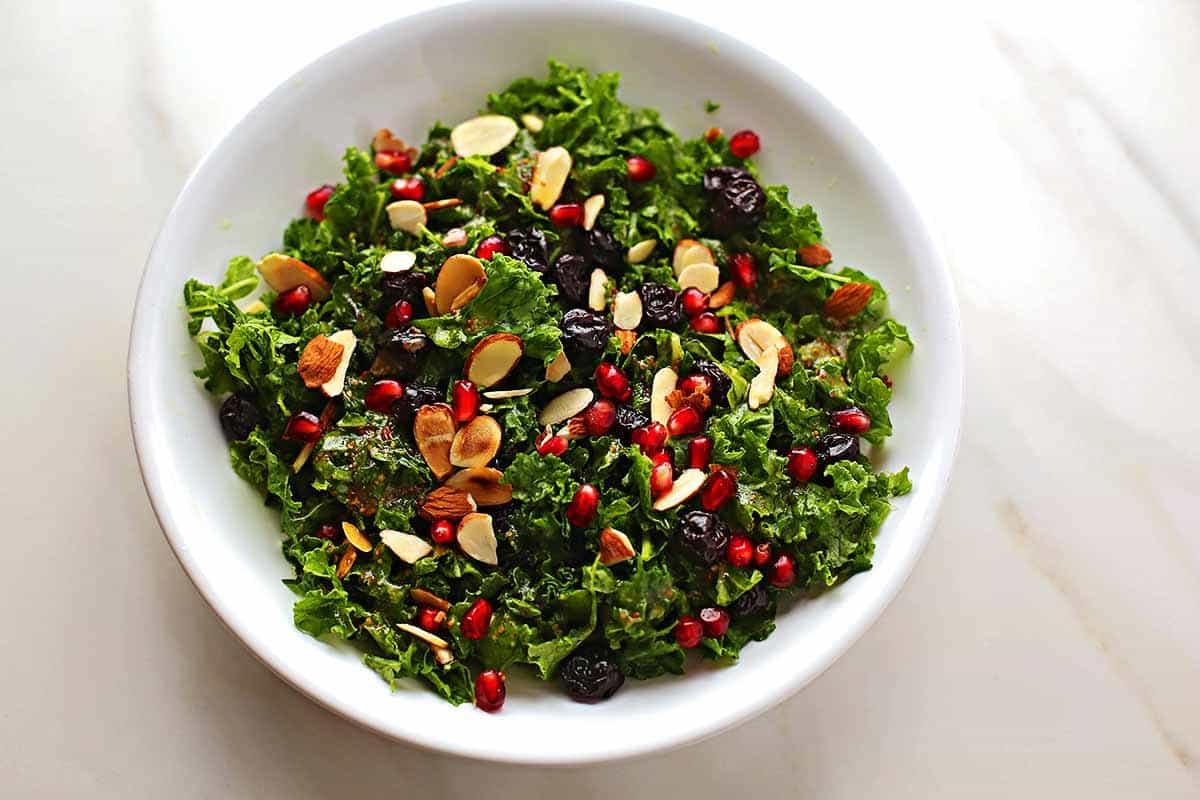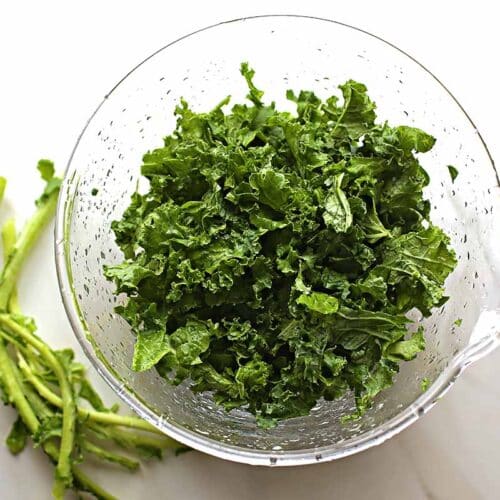It seems like kale is a vegetable you’ll either hate or love because of its strong flavor. If you’ve never tried it, it’s only normal to wonder, “What does kale taste like? And why is it such a big deal?”
It’s easy to assume that because kale looks like spinach, it has a similar taste. But be prepared to be surprised by this green leafy vegetable.
It has a burst of flavor unlike any other, and its many nutritional benefits make it a great addition to your diet.
This versatile ingredient is popular with chefs, nutrition experts, and health and wellness enthusiasts because of the many ways you can incorporate it into recipes and everyday meals.
If you’re just starting your journey to healthy eating, don’t let other people’s opinions about what kale tastes like intimidate you.
Learn more about this hearty vegetable, what it tastes like, and how to prepare it so it tastes even better and you can get enough greens every day.
Jump to Recipe
Kale is a green leafy vegetable from the Brassica family.
Brassica vegetables, also known as crucifers, include broccoli, cabbage, cauliflower, and Brussels sprouts.
Kale thrives in cold weather, so you can easily buy it at supermarkets in the fall and winter.
The stems are elongated, and the edges can be flat or curly.
You can also find kale in various colors, such as red, purple, and white.
Mature kale has tougher leaves and stems. Younger kale has thinner and softer leaves with a weaker taste.
It’s why many people prefer buying young kale because it’s not as strong as mature kale, with a milder flavor that can be easier to get used to.
Kale has a good flavor profile and is low in calories and fat, making it a suitable replacement for lettuce and other greens.
Different types of kale have distinctive tastes, though, so it’s best to try them all to know which ones will work best for your recipe.
There are quite a few kale varieties that can be confusing when you spot them at the grocery or farmer’s market. Here are the most common types of kale and their unique appearance.
It’s the most common type of kale, and you can easily pick it out among leafy green vegetables because of its tight, curly leaves.
Curly kale’s colors can be light green, dark green, or purple. Fresh and mature curly kale is blue-green.
You can eat it raw, although the tough leaves can be challenging to chew. So you can steam, roast, boil, and blanch it to make it easier to eat and allow it to take on more flavors of different aromatics.
Russian kale, also known as Red Russian kale, Ragged Jack, or Canadian broccoli, has flat, broad green-grey leaves, ragged edges, and dark purple veins and stems.
Just by looking at its colors, you can easily pick it out from other types of kale or other leafy greens.
If you’re thinking of growing it in your garden, Red Russian Kale is pretty easy to grow, too.
You can enjoy Red Russian Kale cooked or raw. It turns a darker shade of green when cooked and gives a sweet and nutty flavor.
If you prefer it eaten raw, go for the younger leaves, as mature leaves taste bitter. Toss the kale in salads and enjoy their mild, sweet taste and earthy flavor.
Also known as nero, lacinato, or dinosaur kale, Tuscan kale has puckered leaves that can grow up to two feet long.
Its leaves are deep green, flat, soft, and elongated. The stems are thinner, too, making them easy to eat and ideal for salads and smoothies.
Darker varieties are called cavolo nero, which translates to ‘black cabbage.’
Tuscan Kale is native to Italy and has a milder, sweet flavor. Like the Red Russian Kale, Tuscan Kale is easy to grow. It produces new leaves weekly and grows in any climate.
Its leaves are small, tender, and light green. Baby kale has younger leaves harvested before maturity.
Because of the younger kale leaves, they taste milder and sweeter with a little peppery taste.
If you want to eat kale but are scared of its strong flavor, start with baby kale.
Try adding it to your salad or your pesto. It has a flavor similar to that of baby arugula.
Also Read: Top 19 Kale Substitute Options For Your Next Dish.
Kale has a fairly distinctive taste, which depends on the kale variety.
It has that leafy freshness and tastes like your favorite leafy green vegetables, like cabbage or lettuce.
But in general, what does kale taste like? If you taste it for the first time, you’ll immediately taste its strong, bitter, and earthy flavor.
Moreover, kale is not spicy compared to other greens like rocket or arugula.
Others even find kale to have a slightly sweet flavor.
However, younger kale leaves have a milder taste profile, perfect for anyone who wants to try adding kale to their diet but doesn’t want the strong and bitter kale flavor.
As for texture, raw kale can be delicate and tender or tough and chewy, depending on how you prepare the kale.

Kale is known to have an unpleasant taste when eaten raw. Raw mature kale leaves and stems are dry, crunchy, and tough.
But if you like bitter greens like turnip greens, collard greens, or mature spinach, you’ll like the taste of kale.
It’s better to cook kale to mellow the strong flavors or use the young variety. They have softer and thinner leaves and a milder kale taste.
Kale is a popular ingredient in smoothies because of its many health benefits.
But adding kale to your smoothies will give them a slight green tinge, a rough texture, and a slightly bitter taste.
To mask the taste of kale, you can use other ingredients like nuts, fruits, ginger, peanut butter, and honey, which can make it sweet and creamy.
Many people swear by the many health benefits of kale despite its unpleasant taste.
Incorporate kale into your diet because it’s a low-calorie superfood that helps lower cholesterol, improves heart health, and aids digestion.
It contains vitamin C and vitamins A, B6, and K.
Kale is also loaded with fiber, calcium, iron, and phytonutrient antioxidants.
Aside from benefiting your physical health, it’s good for your mental health, as it provides folate, which is good for brain function.

It’s not a problem buying kale because you can buy it fresh all year round at your local supermarket.
But if it’s your first time buying this leafy green vegetable, look for crisp leaves with no signs of wilting, yellowing, or browning.
Skip the ones with limping leaves and white or yellow spots as well.
After buying, store your kale in the fridge, where it will stay fresh for up to five days.
You can use raw kale if that’s what you prefer. But cooked kale can also enhance the flavors of many dishes that require this leafy green vegetable.
Here are more ideas for using cake in your cooking:
Add chopped kale to make a fresh kale crunch salad. However, add other ingredients to make your fresh kale taste sweet or less bitter.
The raw kale taste can mellow down if you massage the leaves with olive oil and lemon juice. It will also make the tough leaves softer, except if you use baby kale.
Depending on what you like, try adding some olive oil, raisins, parmesan cheese, almonds, and other tasty green vegetables like spinach or arugula.
You can use curly, red, or baby kale for the perfect kale smoothie, as they’re softer, milder, and sweeter than dinosaur kale.
It’s also better to use frozen or cooked kale (steamed), so it’s softer and easier to blend.
Make sure to put softer ingredients first, like fruits or other vegetables, and blend them with a bit of water or liquid ingredients.
Add some ice cubes, and then put your chopped kale last.
Cooked kale makes a great side dish. It’s so easy to prepare and only requires a few ingredients.
Remove the stems and chop your kale and some garlic. Saute it in olive oil and add some salt and pepper to taste.
Sauteed kale can be a side dish or a meal itself. Try using it in your pasta dish, cooked beans, or grains.
It also tastes great as a vegetarian pizza topping!
Stir-fried kale is a delicious and nutritious meal that’s also easy to cook. More importantly, kale can hold its shape in stir-fries.
Add some mushrooms, chicken slices, onions, carrots, and chili peppers to make it an even more special stir-fry.
You can also add other green vegetables, like asparagus, green beans, broccoli, Swiss chard, and bok choy.
Have you ever wondered what baked kale chips taste like? They’re the healthier option for chips and fries and are pretty simple to make!
Get creative with your seasonings―you can use olive oil, parmesan cheese, chopped garlic, paprika, and sesame seeds.
Putting kale in your soups will add flavor and nutritional benefits. It’s perfect for a creamy or savory and satisfying vegetarian soup.
Blend some Tuscan or curly kale in a blender and add them to your potatoes, chicken broth, milk, and butter for a rich and thick soup.
Or stir them into a hearty vegetable soup with your favorite green leafy vegetables.
The kale taste can be intense if you use it for juicing, so go with the kale variety with a milder flavor, like Russian or Tuscan kale.
Wash the kale, remove the center ribs, and tear the kale into smaller pieces.
Add apples, ginger, lemon juice, or cucumber to make your juiced kale taste good.
Instead of using the regular basil pesto, why not make kale pesto?
If you’re worried that the kale pesto taste will be too earthy or bitter, it won’t.
You’ll still get a bright and nutty flavor that will be perfect on your sandwiches, pasta dishes, pizza, eggs, grain bowls, and more.
Not everyone who uses kale in their dishes or beverages loves its strong, bitter flavor.
But the good news is there are ways to improve its taste to make it more flavorful and enjoyable.
Here are some suggestions you can try:
Raw kale can be a challenge to eat, so make it taste better and more tender to chew by giving it a massage.
Put your kale in a bowl and add salt, lemon juice, and olive oil. Massage the leaves to break the fibers down.
Add other salad ingredients and dressing once the kale leaves are soft and greener.
Cooking softens the leaves and makes the intense flavors milder.
Add your favorite spices, seasonings, and ingredients, such as garlic, olive oil, chicken, or vegetable stock, to enhance the flavors of your kale dish, too.
Let the kale cook down and absorb the flavors of the ingredients.
Marinate your kale in a vinegar-based dressing for at least two hours before eating.
This is to tenderize the leaves and give them a more exciting flavor.
Wash and dry your kale first. Then, pat it dry to remove the excess moisture so your kale won’t go bad fast.
Refrigerate your kale if you won’t use it right away. Put it in a plastic bag or airtight food container.
You can also wrap the head of the kale with paper towels before you put it in the bag or container.
Ideally, put it inside the crisper drawer of your refrigerator. If there’s no crisper drawer, just put it at the back of your fridge.
Your kale will stay fresh inside the fridge for up to a week.
If you need to keep kale for longer periods, freezing is the best way.
Wash thoroughly and then remove the stems. Chop the kale into small pieces, then put it in a pot of boiling water with salt.
After a minute or two (or when the kale leaves turn a brighter color), put the leaves in a bowl of ice water. Using a salad spinner, dry the leaves (you can also use paper towels).
Place the leaves on a baking tray and store them in the freezer. When they freeze, transfer them to an airtight container or freezer bag.
Storing kale this way will make it last for up to six months.
Many people think that kale tastes like spinach because of its physical similarities.
But kale has a strong, earthy, and bitter taste, while spinach has a mild, grassy, herb-like, and sweet taste.
Kale also has a rougher and crunchier texture, while spinach keeps its volume and shape better after cooking.
The answer varies on the age and variety of the kale. Kale can be bitter, sweet, or even bland.
In general, kale has a strong and sharp bitterness. But the taste will be milder and thinner if you try young kale leaves.
Caramelized kale tastes sweet and delicious. You can enjoy it on its own or use it as a side dish.
You can try many caramelized kale recipes, the most basic of which is cooking it with large yellow onions and adding salt and pepper to taste.
Cook it with olive oil, garlic, balsamic vinegar, and parmesan cheese. It really depends on what you like.
Now that we’ve answered your question about what kale tastes like, are you ready to give kale a try? Undoubtedly, it’s one of the best vegetables you can add to your diet.
As long as you prepare kale correctly and use other ingredients that will help soften its flavor, you won’t taste the bitter taste of kale that much.






